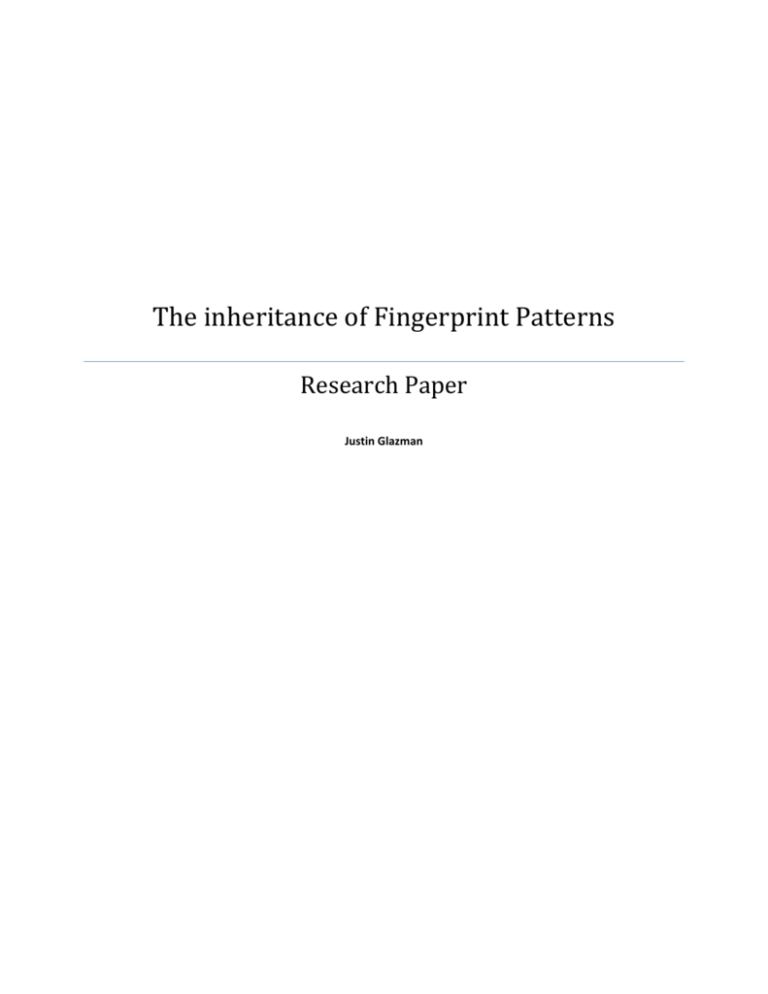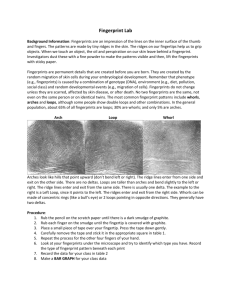The inheritance of Fingerprint Patterns
advertisement

The inheritance of Fingerprint Patterns Research Paper Justin Glazman Outline 1) Intro A) Problem i. Are fingerprints inherited B) Patterns i. Aches ii. Loops iii. Whorls 2) Body A) What are fingerprints/formation i. Series of ridges ii. Found on fingers palms feet iii. Starts on week 10 iv. Ends on week 15 v. Volar pads B) Fingerprint patterns i. Aches 5% bridges/arch-like curve upward absorbed ii. Loops most common( ½ ) loop-up lean somewhat absorbed iii. Whorls more than 1/3 go around a central point not absorbed iv. Adermatoglyphia no fingerprints rare v. No pattern no exact pattern vi. Damaged patterns hard to perform rare C) Genetics i. Thumb semi dominant gene for whorls ii. Ring finger semi dominant gene for whorls recessive gene for loops iii. Middle finger dominant gene for loops iv. Index finger dominant gene for loops v. Pinky finger recessive gene for loops D) Twins and fingerprints i. Twins are similar looks size formation fingerprints ii. similar timing true iii. fingerprints exactly the same false shows randomness Fingerprints are our imprints. These imprints are left everywhere we have touched. The prints are permanent and can withstand more than a cut. There shapes are unique, yet we have put them into three groups: arches, loops, and whorls. On one finger, one out of these three patterns can be there. The question is whether or not the pattern is inherited or if it is random. First, what is a fingerprint? A fingerprint is a series of ridges that create a pattern on our finger and found on humans, apes, monkeys, gorillas, etc. You can also find other prints on your feet and palms. Why you may ask. A tissue called volar pad causes fingerprints to form, yet they can be found only on our fingers, palms, and feet. Our prints start to form when we are 10 weeks old till week 15. During week 10, volar pads, which are only located on the finger, palm, and foot areas, stop growing. While the pads stop growing the finger keeps growing, and the volar pads are pulled into the finger. Ridges start to appear between the times when the volar pads start to get pulled in till it is fully absorbed. The timing of these first ridges is important. Volar pads control overall alignment or pattern of the prints. How absorbed the pads are determines much of the pattern. Much of the spacing and number of ridges are also controlled by that. That is how most of a fingerprint is formed, yet all fingerprints are unique. A key link in fingerprint formation is randomness. Randomness makes every print different. Without it most likely many people would have the same fingerprints. Evidence that there is somewhat of randomness come from twins which I will review later in this paper. Patterns on our fingers form out onto one of three types: arches, loops, and whorls. Although there are many subdivisions of each pattern I am only going through the three main patterns. Beginning with arches, they are the most uncommon. They only count for 5% of fingerprints. Lines or ridges go from one side of the finger to the other in a bridge-like or an arch-like pattern. It will always curve upward, yet the curve decreases the further down the fingerprint. This pattern will form if a volar pad is mostly absorbed while the ridges first appear. More than half of fingerprints are loops making them the most common prints. They have a hill or upside-down U shape. You could say it loops-up. They mostly lean to the left or right. When the volar pads are somewhat absorbed this pattern will form. Whorls count for more than onethird of fingerprints. The ridges go around a central point although some ridges that are further away from this point can branch off and flow differently. The location of this point varies. If the pad has not been absorbed yet or the pad is a bit absorbed this pattern will form. Outside of these three patterns there is a possibility that you could have no prints. Adermatoglyphia is the name of this rare medical condition. Only four families have been found with such prints. You could also have no pattern. People with a weird pattern are said to not have patterns. Such examples like more than two central points or ridges going in all sorts of ways do not have patterns although they could be mistaken for damaged prints. Prints that are damaged look like normal patterns, yet usually with a plain line going through some place on the print. It takes a person who continuously uses their hands to damage their prints making this print quite rare. The genetics for each pattern on a finger were found in an experiment done by a few people. According to their abstract the thumb has a semi dominant gene for whorls. The ring finger has a semi dominant gene for whorls. The middle finger has a dominant gene for loops. On both pinky and ring finger there is a recessive gene for loops. On the index finger there is a dominant gene for loops. I obtained what I could out of their abstract, but some words were mixed up. As I said before, evidence about fingerprint formation comes from twins. Identical twins are similar in many ways including fingerprints. Most likely twins are created very similar because they are formed with the same genetics. This means that the timing when the ridges first appear is exactly the same. That means that both of them should have the same exact fingerprint, yet they do not. Why are they not exactly the same? A missing factor helps make every fingerprint different. Randomness affects the fingerprint a little bit causing every fingerprint to be different, otherwise everyone would have the same prints. Works Cited Langenburg, Glenn Are one’s fingerprints similar to those of his or her parents in any discernable way? Scientific American January 24, 2005 Frenette, Julia Fingerprint patterns Clue November 19, 2011 <http//odec.ca/> Bonniѐ-Tamir, B., M.B. Katznelson, H.M. Slatis The inheritance of fingerprint patterns PMC Journal List November 19, 2011 <http//www.ncbi.nlm.nih.gov/pmc/> Fierro,Pamela Twins and Fingerprints About.com November 13, 2011 <http//www.about.com> What is a fingerprint Ridges and Furrows November 19, 2011 <http://ridgesandfurrows.homestead.com/index.html>






